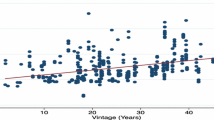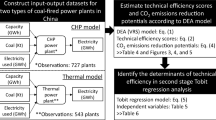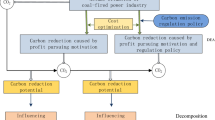Abstract
We estimate carbon mitigation cost (CMC) and the factors determining change in CMC using environmental production function. The CMC index is defined as the ratio of maximum production of electricity under unregulated and regulated production technology. Change in CMC index is decomposed into technical change, scale change and change in the level of CO2 emissions. The production function is estimated for 45 coal-fired thermal power plants over the period of 2008–2012 using data envelopment analysis. Decomposition of CMC change reveals that impacts of changes in scale of operation and CO2 emissions were more than the reduced costs realized due to technical changes. We find that the sample plants in Indian coal-fired thermal power sector had to sacrifice about 3.5% of electricity production amounting to 2005US$ 1702 million of revenue loss over the 5 years due to regulation of CO2 emissions.
Similar content being viewed by others
Notes
India is able to electrify all the villages in April 2018, yet about 20% household have no access to electricity (http://saubhagya.gov.in/ as accessed on May 15, 2018). A village is said to be electrified if electricity is provided to public places and at least 10% of the total number of households are electrified in the village (http://www.ddugjy.gov.in/portal/definition_electrified_village.jsp, accessed on 17.02.2019).
Under the Kyoto Protocol, India was not required to reduce carbon emissions, but at the Paris Agreement, India has pledged to reduce the CO2 intensity of GDP by about 30–35% by 2030 relative to 2005. Reduction in the desired level of the intensity requires India to take some regulatory measures.
Carbon or CO2 mitigation cost (CMC) and pollution abatement cost (PAC) words are used interchangeably throughout the paper.
\({\text{CMC}} = \left( {{\text{CMC index}} - 1} \right) \times {\text{Electricity Output}}\).
Statistical Yearbook 2018, Ministry of Statistics and Programme Implementation, accessed from mospi.gov.in.
Information on thermal power plants is available on financial year basis in India, starting April of a year and closing in the March of following year. Therefore, 2005 refers to April 2005–March 2006 and 2013 refers to April 2013–March 2014.
The Clean Energy Cess has been replaced by a GST Compensation Cess at the rate of INR 400 per metric ton of coal and lignite with effect from July 01, 2017.
Considering the prevailing technology as unregulated technology makes the estimates of CMC upward biased (Färe et al. 2003).
Descriptive statistics in Table 2, reveals that electricity production and CO2 emissions were about 12.14 and 9.03% respectively, higher in 2012 compared to 2008, implying declining carbon intensity of electricity generation. If the intensity was constant over the period then an average plant had produced 216 thousand tons more of CO2 than actually produced, i.e. 9726 thousand tons of CO2 emissions were mitigated by sacrificing 3.5% of electricity production by the sample 45 plants.
Zhou et al. (2008) review the literature on the use of DEA to model environmental performance.
A given technology captures the basic relations between inputs and outputs, based on physical and natural laws. From the technology point of view, emission is not a freely disposable output. It is costly in terms of the good output foregone or in terms of more inputs required to produce same level of good output, i.e. there is a positive trade-off between good output production and emission generation. The prevailing technology is of weak disposability. Strong disposability is a counterfactual case, considered to compute the cost of emission reduction. There are two approaches for modelling free disposability of bad outputs. We follow Färe and Grosskopf (1983) and other subsequent studies in modelling the free disposability of bad outputs, by treating bad outputs equivalent to good outputs. The second approach drops the constraint related to the bad outputs in the maximization of good output or measure of technical efficiency (Färe et al. 2016). The difference between these two approaches of modelling free disposability of bad outputs is inclusion of downward sloping frontier of bad output. Färe et al. (2016) follow the later approach, which does not involve bad outputs under free disposability of bad outputs formulation.
Right to Information (RTI) Act 2005 mandates time bound reply to citizen appeals for government information (http://righttoinformation.gov.in/).
An environmental production function is a special case of an environmental directional distance function, which credits for the expansion of good output. This formulation has been chosen as it replicates Indian CO2 mitigation policy in thermal power sector.
In the measurement of technical efficiency of thermal power plants in India, Singh (1991), Shanmugam and Kulshreshtha (2005), Shrivastava et al. (2012) Sahoo et al. (2017) also assume constant returns to scale (CRS). Some studies measure technical efficiency under variable returns to scale (VRS) by adding a convexity constraint to the CRS model. However, adding a convexity constraint to the CRS model under weak disposability is not equivalent to a VRS model under weak disposability (Färe and Grosskopf 2003). Chen (2013) indicates that VRS model under weak disposability condition is highly nonlinear and is difficult to solve, and the production set is non-convex and non-monotonic.
Technologically there is a positive relation between the production of good and bad outputs, irrespective of the state of regulation. Under regulation, to internalize the emissions effect, the good output is reduced for reducing emissions and in an unregulated situation more of good output is produced simultaneously producing more of bad outputs. However, we use free disposability condition as a counterintuitive case (Färe et al. 2016).
Net electricity generation is defined as gross electricity generation minus auxiliary consumption of electricity which is used by the plant for generation of electricity.
CO2 Baseline Database for the Indian Power Sector, User Guide, Version 11.0, April 2016, CEA.
Domestic coal, used in thermal power plants in India, is assumed to be homogeneous, almost having same heat content. Since plant-wise data on coal quality and heat rate was not available for the study period, consumption of coal has been used. In Indian thermal power plants, use of non-coal fuel is minimal. The plants use oil, only as an ancillary fuel.
Wang et al. (2018) find that CMC is the product of carbon productivity and output elasticity of substitution of CO2 emissions. Output elasticity of substitution (OES) is defined as a ratio of changing rate of the frontier’s desirable output level due to the changing rate of CO2 emissions, i.e. \({\text{OES}} = \frac{\% \Delta y}{\% \Delta b}\). OES indicates the substitution relationship between the desirable output and CO2 emissions. For a plant having higher carbon productivity, the CMC would be higher since the possibilities of substitution will be lower in comparison to a plant having lower carbon productivity.
Year-wise plant level sale price of electricity at current prices was taken from Central Electricity Authority (CEA) and was converted into 2004–2005 level prices, using fuel price index of Reserve Bank of India. The losses are converted to $US, to make it understandable to readers globally.
The terms sub-critical, supercritical, and ultra-supercritical are related to steam operating conditions in the boiler of a plant defined in terms of pressure and temperature. The main steam pressure (MPa) is less than 22.1 for the sub-critical plants, it lies between 22.1 and 25 for supercritical plants and for ultra-supercritical plants this value is higher than 25. Ultra-supercritical and supercritical technologies are more efficient, require less fuel per unit of electricity generated and produces less emissions relative to subcritical plants. In India, generally the power plants in the capacity of 100–600 MW capacity are sub-critical and of greater than 660 MW capacity are supercritical.
References
Ball E, Färe R, Grosskopf S, Zaim O (2005) Accounting for externalities in the measurement of productivity growth: the Malmquist cost productivity measure. Struct Change Econ Dyn 16(3):374–394
Bellas AS (1998) Empirical evidence of advances in scrubber technology. Resour Energy Econ 20(4):327–343
Carlson Curtis, Burtraw Dallas, Cropper Maureen, Palmer Karen (2000) Sulfur dioxide control by electric utilities: what are the gains from trade? J Polit Econ 108:1292–1326
Central Electricity Authority (CEA) (2018) Monthly all India generation capacity report, December 2018, available at the Central Electricity Authority, India’s website. http://www.cea.nic.in/reports/monthly/executive_rep/apr18.pdf
Chen C-M (2013) A critique of non-parametric efficiency analysis in energy economics studies. Energy Econ 38:146–152
Chung YH, Färe R, Grosskopf S (1997) Productivity and undesirable outputs: a directional distance function approach. J Environ Manag 41(3):229–240
Coggins JS, Swinton JR (1996) The price of pollution: a dual approach to valuing SO2 allowance. J Environ Econ Manag 30:58–72
Cui Q, Ye L, Lin J-I (2018) Pollution abatement costs change decomposition for airlines: an analysis from a dynamic perspective. Transp Res Part A 111:96–107
Dhrymes PJ, Kurz M (1964) Technology and scale in electricity generation. Econometrica 32(3):287–315
Du L, Hanley A, Zhang N (2016) Environmental technical efficiency, technology gap and shadow price of coal-fuelled power plants in China: a parametric meta-frontier analysis. Resour Energy Econ 43:14–32
Färe R, Grosskopf S (1983) Measuring output efficiency. Eur J Oper Res 13:173–179
Färe R, Grosskopf S (2003) Nonparametric productivity analysis with undesirable outputs: comment. Am J Agric Econ 85(4):1070–1074
Fare Rolf, Grosskopf Shawna, Pasurka Carl, Weber William (2012) Substitutability among undesirable outputs. Appl Econ 44(1):39–47
Färe R, Grosskopf S, Pasurka CA (1986) Effects on relative efficiency in electric power generation due to environmental controls. Resour Energy 8:167–184
Färe R, Grosskopf S, Lovell CAK, Pasurka CA (1989) Multilateral productivity comparisons when some outputs are undesirable: a nonparametric approach. Rev Econ Stat 71:90–98
Färe R, Grosskopf S, Lovell CAK, Yaisawarng S (1993) Derivation of shadow prices for undesirable outputs: a distance function approach. Rev Econ Stat 75:374–380
Färe R, Grosskopf S, Pasurka CA (2003) Estimating pollution abatement costs: a comparison of ‘stated’ and ‘revealed’ approaches. Working paper series, social sciences research network. http://ssrn.com/abstract5358700
Färe R, Grosskopf S, Noh DW, Weber W (2005) Characteristics of a polluting technology: theory and practice. J Econ 126:469–492
Färe R, Grosskopf S, Pasurka CA (2007) Environmental production functions and environmental directional distance functions. Energy 32:1055–1066
Färe R, Grosskopf S, Pasurka CA (2016) Technical change and pollution abatement costs. Eur J Oper Res 248(2):715–724
Fujii H, Managi S (2015) Optimal production resource reallocation for CO2 emissions reduction in manufacturing sectors. Glob Environ Change 35:505–513
Gollop FM, Roberts MJ (1985) Cost-minimizing regulation of sulfur emissions: regional gains in electric power. Rev Econ Stat 67:81–90
Gupta M (2006) Costs of reducing greenhouse gas emissions: a case study of India’s power generation sector. FEEM working paper no. 147
Halkos G, Managi S (2017) Measuring the effect of economic growth on countries’ environmental efficiency: a conditional directional distance function approach. Environ Resour Econ 68(3):753–775
Jain RK, Kumar S (2018) An analysis of shadow price of CO2 emission in Indian thermal power sector. Environ Econ Policy Stud 20(4):879–902
Johnstone N, Managi S, Rodríguez M, Haščič I, Fujii H, Souchier M (2017) Environmental policy design, innovation and efficiency gains in electricity generation. Energy Econ 63:106–115
Kolstad CD, Turnovsky MHL (1998) Cost functions and nonlinear prices: estimating a technology with quality-differentiated inputs. Rev Econ Stat 80(3):444–453
Kumar S (2006) Environmentally sensitive productivity growth: a global analysis using Malmquist–Luenberger index. Ecol Econ 56:280–293
Kumar S, Khanna M (2009) Measurement of environmental efficiency and productivity: a cross country analysis. Environ Dev Econ 14:473–495
Kumar S, Managi S (2011) Non-separability and substitutability among water pollutants: evidence from India. Environ Dev Econ 16:709–733
Kumar S, Fujii H, Managi S (2015) Substitute or complement? Assessing renewable and non-renewable energy in OECD countries. Appl Econ 47(14):1438–1459
Liu Y, Sumaila R (2010) Estimating pollution abatement costs of salmon aquaculture: a joint production approach. Land Econ 86(3):569–584
Lowe PD (1979) Pricing problems in an input-output approach to environment protection. Rev Econ Stat 61(1):110–117
Marklund P-O, Samakovlis E (2007) What is driving the EU burden-sharing agreement: efficiency or equity? J Environ Manag 85(2):317–329
Martin DW, Braden JB, Carlson LJ (1990) Estimation of process change for industrial pollution abatement. J Air Waste Manag Assoc 40:211–216
Matsushita K, Asano K (2014) Reducing CO2 emissions of Japanese thermal power companies: a directional output distance function approach. Environ Econ Policy Stud 16:1–19
Ministry of Environment and Forest (MoEF) (2010) India—Greenhouse Gas Emission 2007, a report by Indian Network for Climate Change Assessment, Ministry of Environment and Forests, Government of India. http://moef.nic.in/sites/default/files/Report_INCCA.pdf
Murty MN, Kumar S (2003) Win–Win opportunities and environmental regulation: testing of porter hypothesis for indian manufacturing industries. J Environ Manag 67(2):139–144
Murty MN, Kumar S, Dhavala KK (2007) Measuring environmental efficiency of industry: a case study of thermal power generation in India. Environ Resour Econ 38:31–50
Park H, Lim J (2009) Valuation of marginal CO2 abatement options for electric power plants in Korea. Energy Policy 37:1834–1841
Pasurka CA (2001) Technical change and measuring pollution abatement costs: an activity analysis framework. Environ Resour Econ 18(1):61–85
Pasurka CA (2008) Perspectives on pollution abatement and competitiveness: a review of data and analyses. Rev Environ Econ Policy 2(2):194–218 (Summer)
Picazo-Tadeo AJ, Reig-Martinez E, Hernandez-Sancho F (2005) Directional distance functions and environmental regulation. Resour Energy Econ 27:131–142
Pittman RW (1981) Issues in pollution control: interplant cost differences and economies of scale. Land Econ 57:1–17
Pittman RW (1983) Multilateral productivity comparisons with undesirable outputs. Econ J R Econ Soc 93(372):883–891
Porter M, van der Linde C (1995) Toward a new conception of the environment–competitiveness relationship. J Econ Perspect 9(4):97–118
Sahoo NR, Mohapatra PKJ, Sahoo BK, Mahanty B (2017) Rationality of energy efficiency improvement targets under the PAT scheme in India—a case of thermal power plants. Energy Econ 66:279–289
Shanmugam KR, Kulshreshtha P (2005) Efficiency analysis of coal-based thermal power generation in India during post-reform era. Int J Glob Energy 23:15–28
Shrivastava N, Sharma S, Chauhan K (2012) Efficiency assessment and benchmarking of thermal power plants in India. Energy Policy 40:159–176
Singh J (1991) Plant size and technical efficiency in the Indian thermal power industry. Indian Econ Rev 26:239–252
Swinton JR (2002) The potential for cost saving in the sulfur dioxide allowance market: empirical evidence from Florida. Land Econ 78:390–404
Wang Y, Wang Q, Hang Y, Zhao Z, Ge S (2018) CO2 emission abatement cost and its decomposition: a directional distance function approach. J Clean Prod 170:205–215
World Resources Institute (WRI) (2012) Global coal risk assessment—data analysis and market research, a working paper by World Resource Institute. http://www.wri.org/publication/global-coal-risk-assessment
Yagi M, Fujii H, Hoang V, Managi S (2015) Environmental efficiency of energy, materials, and emissions. J Environ Manag 161:206–218
Zhou P, Ang BW, Poh KL (2008) A survey of data envelopment analysis in energy and environmental studies. Eur J Oper Res 189(1):1–18
Zhou P, Zhou X, Fan LW (2014) On estimating shadow prices of undesirable outputs with efficiency models: a literature review. Appl Energy 130:799–806
Funding
The study has not received any funding from any source.
Author information
Authors and Affiliations
Corresponding author
Ethics declarations
Conflict of interest
Both the authors declare that they do not have any conflict of interests.
Ethical approval
This article does not contain any studies with human participants or animals performed by any of the authors.
Additional information
Publisher's Note
Springer Nature remains neutral with regard to jurisdictional claims in published maps and institutional affiliations.
Rights and permissions
About this article
Cite this article
Kumar, S., Jain, R.K. Cost of CO2 emission mitigation and its decomposition: evidence from coal-fired thermal power sector in India. Empir Econ 61, 693–717 (2021). https://doi.org/10.1007/s00181-020-01892-6
Received:
Accepted:
Published:
Issue Date:
DOI: https://doi.org/10.1007/s00181-020-01892-6










